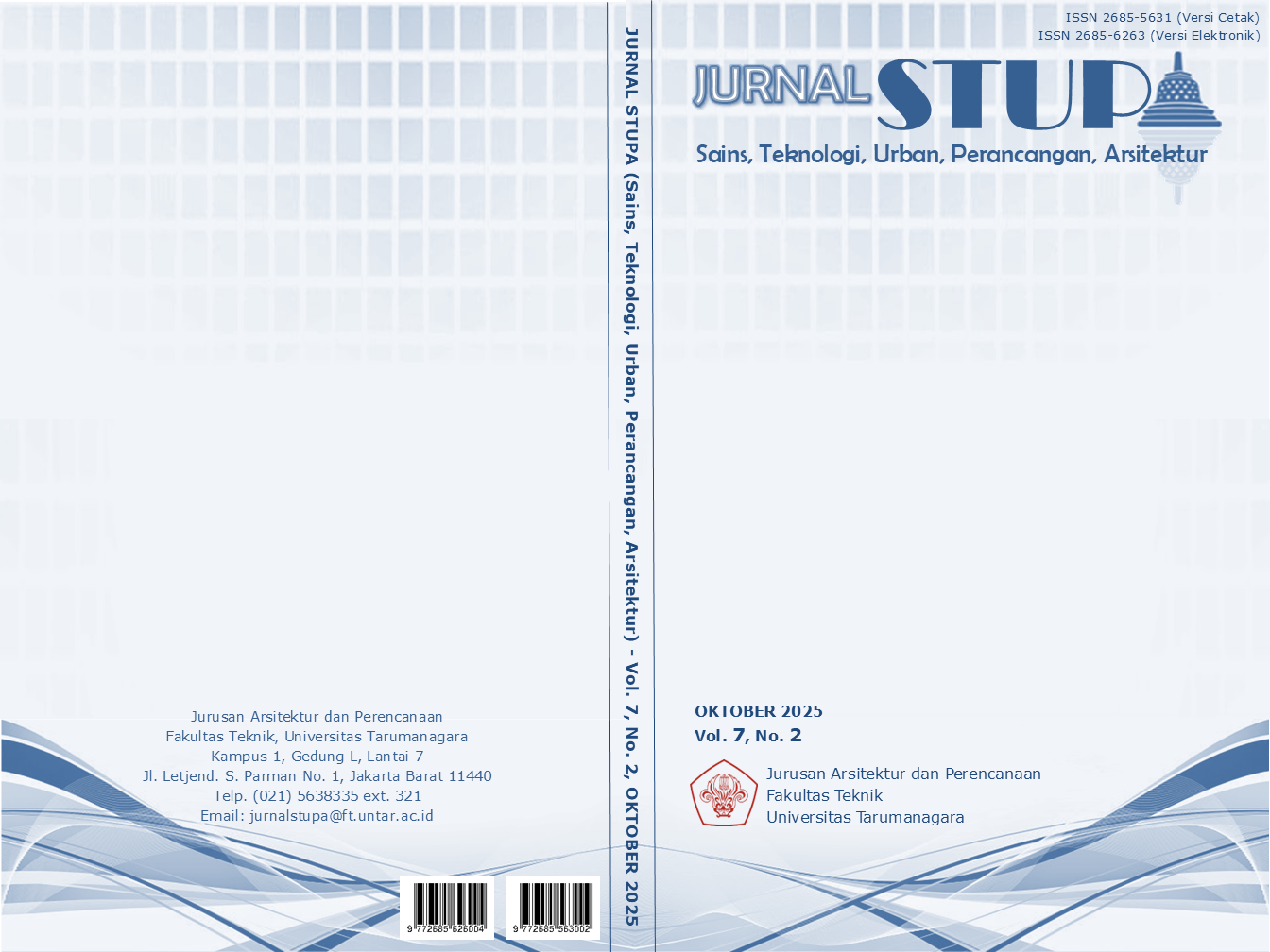PUSAT DAUR ULANG KENDARAAN AKHIR MASA PAKAI DI JAKARTA DENGAN PENDEKATAN ARSITEKTUR REGENERATIF
Main Article Content
Abstract
The annual increase in motor vehicle ownership in Jakarta has led to a rise in the number of End-of-Life Vehicles (ELVs), which significantly contribute to environmental degradation, public health concerns, and traffic safety risks. In response, the local government has introduced regulations to limit vehicle age; however, the absence of dedicated, professionally managed ELV processing facilities remains a critical gap. This study aims to formulate a design strategy for an ELV recycling facility using a regenerative architecture approach is an approach that not only addresses the technical challenges of waste management but also generates ecological and social value for urban communities. The literature review includes theories of regenerative design and comparative studies on ELV recycling systems and regulations in Japan, Europe, and China to identify effective design patterns that promote collective responsibility in managing vehicular waste. The research adopts a qualitative method based on contextual analysis of a selected site in Jakarta, synthesized through spatial and programmatic strategies. The resulting design proposes a prototype facility that integrates industrial ELV processing zones with publicly accessible educational spaces, organized in a vertical configuration to optimize land use and maintain visual transparency. This project demonstrates how waste processing infrastructure can also serve as a catalyst for urban regeneration, support circular economy practices, restore environmental quality, and foster active social engagement. The facility acts as a regenerative medium that unites ecology, education, and community within a sustainable architectural framework.
Keywords: circular economy; end-of-life vehicle; Jakarta; regenerative architecture; vehicle recycling
Abstrak
Pertumbuhan jumlah kendaraan bermotor di Jakarta setiap tahunnya meningkatkan jumlah kendaraan yang mencapai akhir masa pakainya (End-of-Life Vehicle/ELV). Keberadaan ELV berdampak signifikan terhadap penurunan kualitas lingkungan, kesehatan publik, dan keamanan berkendara. Pemerintah merespons hal ini dengan menerbitkan regulasi pembatasan usia kendaraan, Namun hingga saat ini, belum tersedia fasilitas pengolahan ELV yang dikelola secara profesional dan terintegrasi dalam sistem kota. Penelitian ini bertujuan untuk merumuskan strategi perancangan fasilitas pengolahan ELV dengan pendekatan arsitektur regeneratif yakni pendekatan yang tidak semata-mata menyelesaikan persoalan teknis limbah, melainkan turut merekonstruksi nilai ekologis dan memperkuat kohesi sosial melalui pendekatan spasial regeneratif. Kajian literatur mencakup teori arsitektur regeneratif serta studi sistem dan regulasi daur ulang ELV di Jepang, Eropa, dan China untuk mengidentifikasi pola desain yang dapat mendorong tanggung jawab kolektif terhadap pengelolaan limbah kendaraan. Metode penelitian menggunakan pendekatan kualitatif berbasis studi kontekstual terhadap satu tapak di Jakarta, yang kemudian dianalisis melalui sintesis spasial dan programatik. Hasil rancangan menghasilkan prototipe fasilitas yang memadukan zona industri pengolahan ELV dengan ruang publik edukatif dalam konfigurasi vertikal yang efisien dan terbuka secara visual. Proyek ini menunjukkan bahwa fasilitas pengolahan limbah dapat menjadi instrumen regenerasi kota yang mendukung circular economy, memulihkan kualitas lingkungan, dan menciptakan keterlibatan sosial yang aktif. Bangunan ini berfungsi sebagai medium regeneratif yang menyatukan ekologi, edukasi, dan komunitas dalam satu sistem arsitektur yang adaptif dan berkelanjutan.
Article Details

This work is licensed under a Creative Commons Attribution-NonCommercial-ShareAlike 4.0 International License.
This work is licensed under a Jurnal Sains, Teknologi, Urban, Perancangan, Arsitektur/ STUPA Creative Commons Attribution-NonCommercial-ShareAlike 4.0 International LicenseReferences
Baper, S. Y., Khayat, M., & Hasan, L. (2020). Towards Regenerative Architecture: Material Effectiveness. International Journal of Technology, 11(4), 722-731. Opgeroepen op Mei 15, 2025
Numfor, S. A., Omosa, G. B., Zhang, Z., & Matsubae, K. (2021). A Review of Challenges and Opportunities for End-of-Life Vehicle Recycling in Developing Countries and Emerging Economies: A SWOT Analysis. Sustainability, 13(9), 4918. doi:https://doi.org/10.3390/su13094918
Sitinjak, C., Ismail, R., Fajar, R., Bantu, E., Shalahuddin, L., Yubaidah, S., . . . Simic, V. (2023). An Analysis of End-of-Life Vehicle Management in Indonesia from the Perspectives of Regulation and Social Opinion. International Journal of Technology, 14(3), 474-483.
Sun, L. (2021). Institutional, Technology, and Policies of End-of-Life Vehicle Recycling Industry and Its Indication on the Circular Economy-Comparative Analysis Between China and Japan. Frontiers in Sustainability, 2. doi:10.3389/frsus.2021.645843



